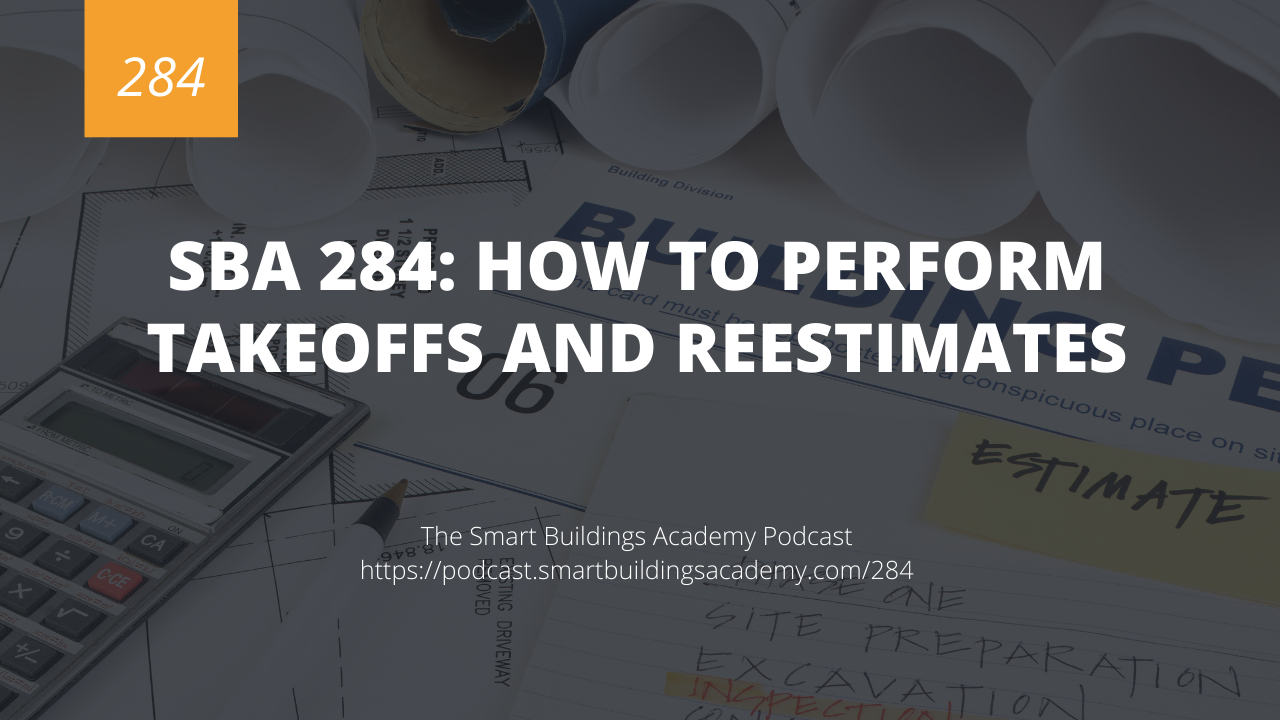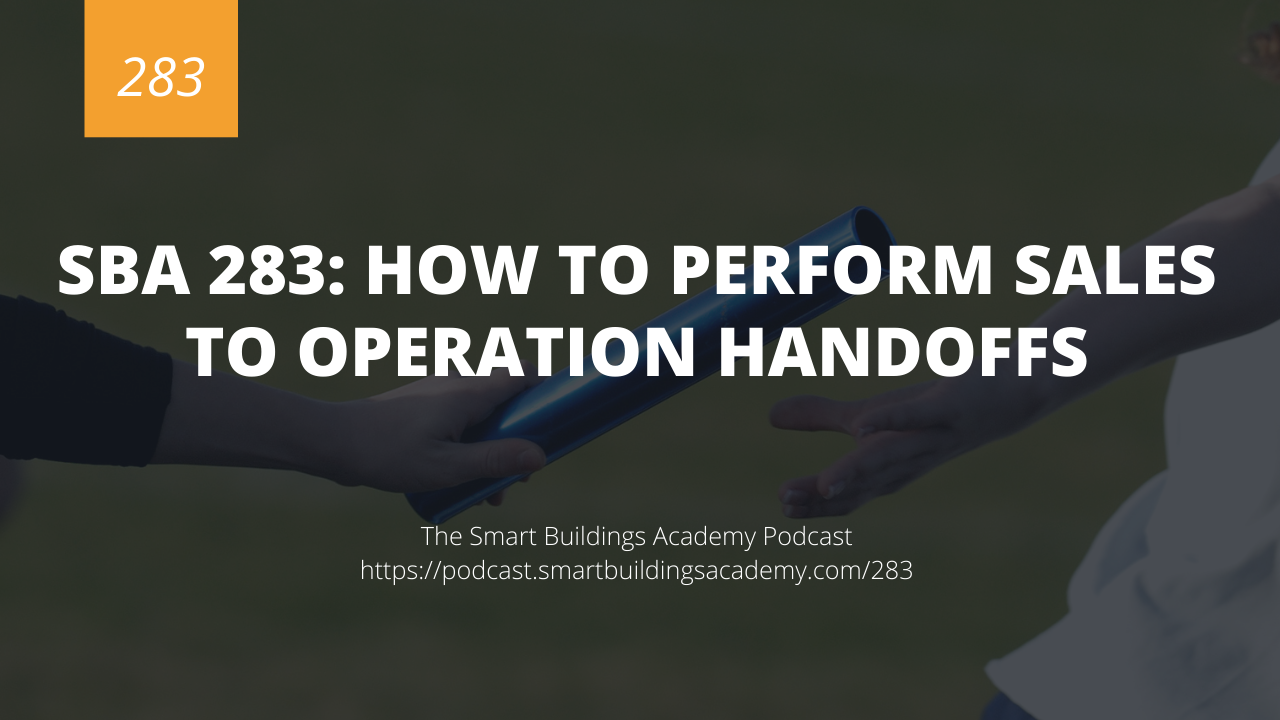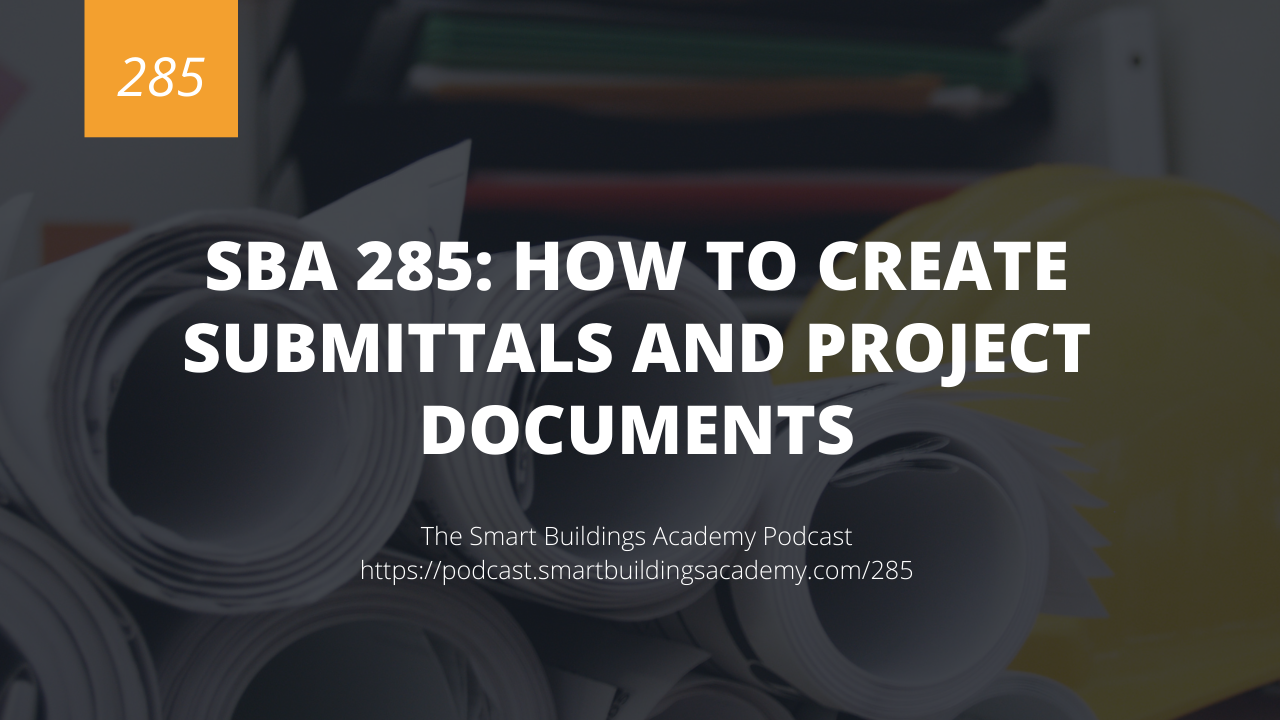In this episode of the Smart Buildings Academy Podcast we discuss how to perform takeoffs and reestimates after the sales to operations handoff process.
Click here to download or listen to this episode now.
Resources mentioned in this episode


Transcript
Phil Zito 0:00
This is the smart buildings Academy podcast with Phil Zito Episode 284 Hey folks, Phil Zito here and welcome to Episode 284 of the smart buildings Academy podcast. And in this episode we are going to be talking about how to perform takeoffs and re estimates. As always, this podcast episode can be found in its resources can be found at podcast smart buildings academy.com forward slash 284. Once again, that is podcast as smart buildings academy.com forward slash 284. Okay, so let's talk about how to perform takeoffs and re estimates. And in order to do that, we have to go back to last episode which was 283, which was performing sales operations handoffs. Okay, so picture this, you're sitting in your little conference room, your salesperson has just brought in a job that they've set down, you've went through the sales to operations handoff, and you've identified the scope of the work, you figured out exactly what's in scope, what's not in scope, you figured out kind of a lay of the land for the mechanical systems, what you're going to be just taking care of. And you are now moving into the first step of almost every building automation project, which is creating your project submittals and project documents, which by the way, we'll talk about in Episode 285, in great detail. But right now, we are focused on doing that kind of last step of the sales to operations handoff, which is so critical yet so few people do it, which is to perform a complete takeoff, and then to perform a re estimate. Now what is a takeoff a takeoff is reviewing the documents within the project and then getting information from those documents and for takeoffs, we have a seven step process of which three of those steps are optional. So step one is going to and I'll go through each one of these steps in greater detail, but step one is going to be performing a proper equipment count. Step two is creating a material list. Step three is filling out a scope matrix. And step four really is to identify the specification to construction document disparities. Now in between those steps are in between step three and four are three optional steps which are to identify specialized equipment, identify integrations and identify any additional labor like test and balance, commissioning training excetera things that are going to cost you more. So as we do this, as we approach this, here's the mindset I want you to be in and I'm going to paint a mind picture for you because I believe that this will help you visualize it, which will then help you internalize it, which will then help you to apply it. So picture this, you're in that same conference room. you've painted out these 24 by 36. Mechanical plans. Can you feel the paper? Have you ever touched a mechanical plan? Can you feel them? Can you feel kind of the weight, how you're concerned, when you're turning that page, you don't want to rip that page, right? So you've got this massive chunk of information just sitting in front of you on the drafting desk or on the table. And then you've also got the sequence of operations printed out and you also have it in electronic format so that you can search it. And you start turning those pages to about the middle of the mechanical drawing set. And you come to the equipment schedule. And it's here that we begin to perform our equipment count. And what I like to do how I like to approach this is I like to first start with the terminal units and then work my way up. Some folks like to start with the major utility systems and work their way down. I like to start with the terminal units and the smaller individual systems and work my way up. And the reason I like that is it starts to paint a picture to me of how the building's going to be built of how things are going to interlock how things are going to interface. So as I figure out oh V's one through 12 Well, they're served by air handler one, and vV 13 through 22 are served by air handler to an air handlers one and air handlers two are served by chiller one and boiler one. And I start to paint this picture of what exactly is going on on this jobsite and when I start to understand that I start to also see Oh, there's exhaust fans right? There's fan coil units. Oh these exhaust fans are located right next to V a v 10.
Phil Zito 4:56
Well guess what I can do a different v v controller. And get some additional IO so that I can map in those exhaust fans write the status and commands. And at this point, I'm starting to create a material list. So I start to go and at the terminal units, I write down, okay, zone temp. So in temp setpoint, you know, maybe I need a set point adjust per the spec. And this is where I'm bouncing between my equipment schedule. And my specifications section two, which is going to be materials or products. Okay, so section two material or products are going to specify what kind of sensors what kind of valves, what kind of actuators, which kind of control devices, flow sensors, etc, so that I can start to build out my material list. So I'm building out this material list. And you might say to yourself, but isn't that the point of submittals. And this is where things get a little bit different. And this isn't for everyone, I will admit that some folks, they only want to build the material list once and they build it in the submittal phase. What I like to do personally is perform an equipment count, build my material list, build my scope matrix, make sure it's in line with what the salesperson has in their estimate, and in their proposal letter. And then I hand that off to the designer and the designer, literally, they are validating one lines, they are going to be validating network risers creating network risers, they're going to be validating sequences and doing any rfis and RFCs. On sequences, they're more so focused on the function of the system's knowing that the parts and pieces have already been selected. And this also will make submittal submission much faster. So that you can go and have all of this catalog sheets, material lists, etc. Now I know this may seem like a lot of work, but actually building material list is not very difficult, because a lot of systems are typical. So you may have 400, va v boxes, but they're typical of three types cooling, only a reheat and maybe a series fan power reheat. So you really only have to create three material lists for your terminal units. So we create this material list, we build it out. And then we move on to our scope matrix, we start to build out our scope matrix. And this is where we understand, okay, our scope is an air handler. And then we compare that air handler sequence to the specifications sequence. And we see if there's any kind of disparities. And we really start to submit our RF eyes and our AR C's to clarify those disparities, because those disparities are much easier to clarify early on. before you've ordered material before you've submitted submittals. Because I will tell you, oftentimes, if you want the cheap band, the poor man the lazy man's way out of submittal submission with a lot of engineers, you can simply copy the sequence of operation that is in the specification handed off to them in the submittal. And they will stamp it good. As long as you follow their material less to the letter in section two. And you followed their sequences in section three execution to the letter and you've literally like use snipping tool to grab those and pull those out and put them on a Visio diagram. For the submittal set, you'll get your submittals approved, it's one of the easiest ways to get your submittals approved. It's also one of the easiest ways to get hosed and bent over when you're doing commissioning, because the commissioning agent is going to have a different interpretation of the sequence of operations. Which brings us to our three additional categories. I'm gonna take a sip of coffee real quick one second are three additional
Phil Zito 8:51
sections here right. So these are going to be identify specialized equipment, identify integrations and identify additional labor. specialized equipment and integrations are typically going to be in part one general of the specification, are typically going to find them usually with on the first or second page of the specification, where it's going to call out any additional integrations or any specialized equipment and any related sections that you need to tie into additional labor like test and balance commissioning and training that is typically going to be covered in section three execution. That's where you're going to find those additional categories. So that's where you want to be checking when you're doing your takeoffs. So at this point, we have a material list by system. We have a scope matrix detailing out what exactly we should do. We've identified any specification to MEP document disparities. And we've said okay, you know, I see your sequence of operations, it's calling for an ARV air handler. So energy recovery air handler, right. But yet, I go into the MEP set and it's a one line package for rooftop. There's No energy recovery, what? What is it? What should I account for. And these are the things that you need to like rapidly clarify with RFID and RFCs. So requests for information or requests for information that you don't already have requests for clarification or clarification on information you already have. And we'll talk much more about RFID and RFCs. And using them as competitive strategies in our sales session, or sales podcast episodes, which will be in probably a month and a half. But we will also talk about RFID and RFCs. Later on in this when we start to look at change orders, and things of that nature. So up to this point, we've created a material list, we've created a scope list, we've submitted our RFID and RFCs. To clarify our information, we've gotten our information back. And we've realized that labor's way off, maybe it's way under, maybe it's way over, we've realized material costs are wrong, our subs, we want to get a rough estimate on our sub costs. And we go and we submit for re estimates. Now a re estimate does not involve the contractor, or re estimate is truly an internal process in which we are going. And we are looking at our costs. And we are truing up our costs by either consuming some of the profit that's in the project, or by adding more profit back to the project by reducing our costs. And it's important you do both, right, it's important that we do both. Because if we notice, hey, these are all factory mounted controls for our terminal units. And all we have to do is send our terminal units to the factory, get our controls mounted. And we realize, hey, we can dramatically reduce our installation labor, then we definitely need to do that right, we need to go and get that done. Because at the end of the day, that's additional cost that we should not be carrying. And what we need to do is two things. One, we need to positively re estimate the project. So we take the cost of that labor, for
Phil Zito 12:26
installing the controls on the terminal units. And we transferred to profit now you'll get some folks who will push back, because either they're not fully confident in their project management processes, they've been burned in the past by bad estimates, and they just want to have that wiggle room. And there's two schools of thought by going and having that wiggle room. Right, he by leaving that cost into the project. At the end of the project, if you don't use the cost, you just positively re estimate the project. The problem with that is recognizing the profit a year from now versus right away, if you're able to recognize profit right away, and you're able to take that out and apply it to the business that's good for the business. But if you have to wait until the end of the project in order to recognize profit, you know, that is time of which your business is not operating. With that profit at its fingertips, that profit is still trapped into the basically the p&l of the project. So we've got to be considerate of that. And you're going to notice a lot of things I teach are going to look at things from a realistic way, like, hey, let's keep that cost in there so that we can protect ourselves. And let's be real about that maybe we don't trust our ops team, maybe we got a new ops team, maybe we're still trying to figure things out, maybe this is a new type of project for us. And we just want to have that extra cost in there. But at the same time, I also have to balance that reality with being a business owner and saying, Hey, you know, businesses exist at their core unless they're nonprofits to make profit and grow the profit of the shareholders, whether that's the owner, whether that is actual shareholders, etc. So we need to be aware of that when we approach this. But like I said, we go and we do our ri estimates, we do either positive or negative ri estimates and then we take that into our feedback loop and feed that back to the sales team. While we remove this much profit, or we added this much profit back to the project because of x, y z so that the sales team is aware Hey, I'm in a competitive bid situation. Now, I know this engineer likes to do factory mounted controls. So and I'm going to look for that in the spec. Oh I found it I found the factory man of controls in the spec language or in the equipment schedule under the notes. And now that I know this, I am going to remove that cost for my project and hopefully my competitors don't notice this as well. And now I'm Going to be at a lower price than my competitors for the actual scope of the project. And that will really help you a lot in selling. Now, let's go and recap real quickly on the take off process, we're going to do it again slowly,
Phil Zito 15:17
I'm going to talk through each one in somewhat of a detail, and then we're going to close out the episode. So performing proper equipment counts as going to the equipment schedule, counting out your equipment, and ensuring that that equipment schedule is accurately aligned with the specification and the scope of work. Then we create a material list, this is where we create, I typically do all this in Excel, we create a tab for each piece of equipment with their material list. So this is a bill of materials. Now that being said, you only have to do this for typical systems. So if you have 100, cooling only vv boxes, and they're typical of one type of system, meaning that there are only one layout for that 100 boxes, each one is the same layout, then you only have to build one bill of material, then we fill out our scope matrix and our scope matrix is going to detail out what is in scope for us and what's not this is really going to help our submittal team as they move through the submittal document creation. So is that bill of materials and that equipment count. Then we go and we solve any specifications, construction document disparities, you know, sequence mismatches, things that are calling for complex sequences, but you've got a packaged rooftop with no capabilities, those are things you need to call out and clarify. And then if there is any identified specialized equipment, integrations or additional labor, you address those as well in your costing either through positive estimates or deductive estimates. And the re estimate process is simply going in comparing the existing cost structure allocation of labor material and subcontractors and comparing that to what you have seen as the actual required allocation of material subcontractors and labor. Okay, I hope this helps I hope this gives you a starting point and a framework for doing takeoff templates if this is something you'd like to learn more about I encourage you to go to podcast at smart buildings academy.com forward slash 284 once again that is podcast dot smart buildings Academy calm for slash 284 and is there you can learn about our design course is there you can learn about our scoping estimating course as well. And both of those courses will help you in performing estimates and takeoffs. Thanks a ton and take care





